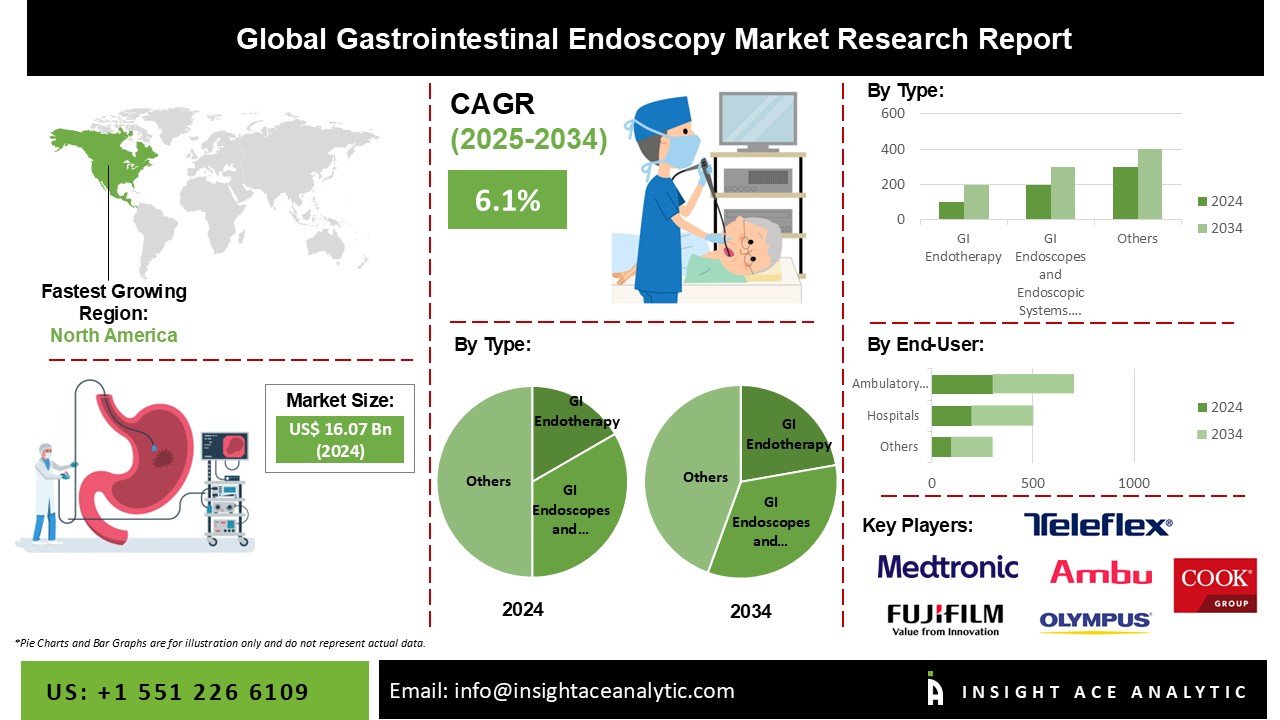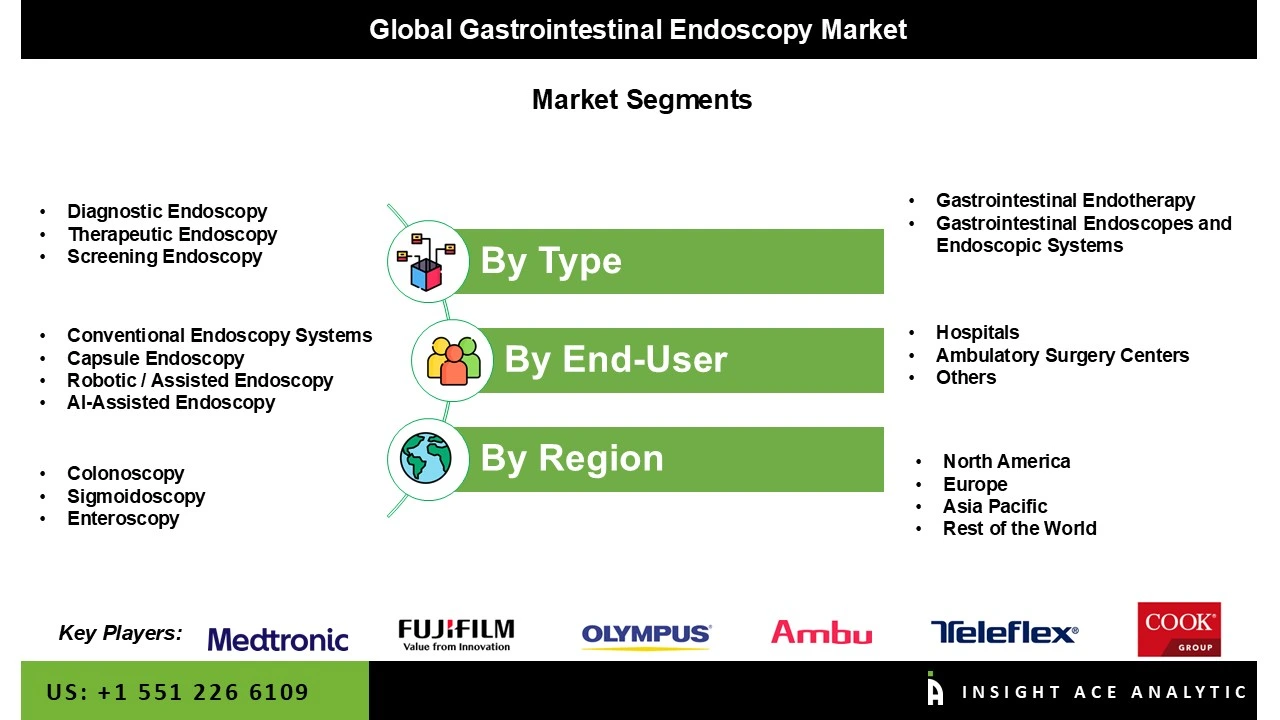Gastrointestinal Endoscopy Market Size is valued at USD 16.07 billion in 2024 and is predicted to reach USD 28.74 billion by the year 2034 at a 6.1% CAGR during the forecast period for 2025-2034.
Key Industry Insights & Findings from the Report:

A gastrointestinal endoscopy, also known as gastroscopy or digestive endoscopy, is a diagnostic and therapeutic procedure for illnesses of the upper digestive tract. The oesophagus, stomach, and duodenum form the upper digestive system (the first part of the small intestine). The endoscope device is introduced through the mouth, and the acquired images are presented on the monitor in real-time and/or recorded as the endoscope moves through the body. Endoscopy is occasionally performed with other procedures, such as an ultrasound. Attaching an ultrasound probe to the endoscope creates images of the oesophagus or stomach wall. Endoscopic ultrasound can also be used to create images of inaccessible organs, such as the pancreatic. Newer endoscopes utilise high-definition video to provide images with greater clarity. Numerous endoscopes employ a narrow band imaging technology that uses specialised light to improve the detection of precancerous diseases like Barrett's oesophagus. Modern endoscopy has shown to be immensely valuable in many fields of medicine because it entails relatively few risks, produces detailed images, and is rapid to do.
The gastrointestinal endoscopy market will be driven by factors such as an increasing need for endoscopy, the progress of new technologies, an increase in investments and funding, an increasing number of cases of gastrGlobal Gastrointestinal Endoscopy Market ointestinal illnesses, and increasing demand for procedures that are minimally invasive. Also, new device approvals will play an essential role in developing gastrointestinal endoscopy. In Feb 2022, Ambu announced that the FDA had approved their Ambu® aScopeTM Gastro and Ambu® aBoxTM 2 Single-Use Gastroscope and Next-Generation Display Unit. Ambu's solution addresses the current drawbacks of reusable endoscopes with advanced technology, portability, and cost-effectiveness, making it a suitable alternative for customers looking to perform gastroscopies in a variety of care settings (including endoscopy unit, OR, ICU, ER, ASC).
However, the high cost of endoscopic operations, adverse healthcare development, and limited reimbursement will hinder the growth of the market for gastrointestinal endoscopy. However, the expanding healthcare market in emerging nations and the development of gastrointestinal endoscopic devices will create several growth prospects for the gastrointestinal endoscopy market throughout the forecasting period.
· Olympus Corporation (Japan)
· Boston Scientific Corporation (USA)
· Medtronic plc (Ireland / USA)
· FUJIFILM Corporation (Japan)
· KARL STORZ SE & Co. KG (Germany)
· HOYA Corporation (Japan) — PENTAX Medical Division
· Johnson & Johnson (USA) — Ethicon / J&J MedTech
· Cook Medical (USA)
· Stryker Corporation (USA)
· B. Braun Melsungen AG (Germany)
· CONMED Corporation (USA)
· Smiths Group plc (UK)
· Ambu A/S (Denmark)
· Richard Wolf GmbH (Germany)
· STERIS plc (USA)
· Arthrex, Inc. (USA)
· EndoTheia, Inc. (USA)
· SteriView Technologies (USA)
· Solos Endoscopy, Inc. (USA)
· Dome Medical Technologies (USA)
· Lazurite Corporation (USA)
· CapsoVision, Inc. (USA)
· SonoScape Medical Technology Co., Ltd. (China)
The Gastrointestinal Endoscopy Market is segmented into two major segments Types and End-User. By type, the market is widely classified. First is Gastrointestinal Endotherapy, which includes ERCP Devices, Gastrointestinal Stents, Balloon Dilators, Ultrasound Endoscopes, Biopsy Devices, Hemostasis Devices, Retrieval Devices, and Others. The gastrointestinal Stents category is subdivided into Esophageal Stents, Biliary Stents, and Pancreatic Stents. In comparison, the Biopsy Devices category is again divided into Biopsy Forceps, Polypectomy Snares, and Other Biopsy Devices. The second is Gastrointestinal Endoscopes and Endoscopic Systems, which contains three sub-divisions: Gastrointestinal Videoscopes, Visualization Systems, and Capsule Endoscopes. The sub-division Gastrointestinal Videoscopes comprises Gastroscopes, Colonoscopes, Duodenoscopes, Sigmoidoscopes, Enteroscopes and Anoscopes. The second significant segment, the End-User segment, includes, Hospitals, Ambulatory Surgery Centers, and Others.
In 2021, North America dominated the market. The introduction of new endoscopic devices will fuel market growth in North America. In addition, the increased prevalence of gastrointestinal illnesses, cancer, and other chronic conditions, as well as the rising desire for minimally invasive procedures, will increase North America's global market share.
| Report Attribute | Specifications |
| Market size value in 2024 | USD 16.07 Bn |
| Revenue forecast in 2034 | USD 28.74 Bn |
| Growth rate CAGR | CAGR of 6.1% from 2025 to 2034 |
| Quantitative units | Representation of revenue in US$ Million and CAGR from 2025 to 2034 |
| Historic Year | 2021 to 2024 |
| Forecast Year | 2025-2034 |
| Report coverage | The forecast of revenue, the position of the company, the competitive market structure, growth prospects, and trends |
| Segments covered | By Type, By Application, By Technology, By Disease and End-User |
| Regional scope | North America; Europe; Asia Pacific; Latin America; Middle East & Africa |
| Country scope | U.S.; Canada; U.K.; Germany; China; India; Japan; Brazil; Mexico ; France; Italy; Spain; South Korea; South East Asia |
| Competitive Landscape | Boston Scientific Corporation, Medtronic plc, KARL STORZ SE & Co. KG, Ambu A/S, Teleflex Incorporated, HOYA Corporation, Olympus Corporation, FUJIFILM Holdings Corporation, Cook Group Inc, SonoScape Medical Corp., EndoMed Systems GmbH, CapsoVision, Inc., HuiZhou Xzing Technology Co., Ltd., Endogene Ltd., Envaste Limited |
| Customization scope | Free customization report with the procurement of the report, Modifications to the regional and segment scope. Particular Geographic competitive landscape. |
| Pricing and available payment methods | Explore pricing alternatives that are customized to your particular study requirements. |
By Type
· Gastrointestinal Endotherapy Devices
o ERCP Devices
o Gastrointestinal Stents
§ Esophageal Stents
§ Biliary Stents
§ Pancreatic Stents
o Balloon Dilators
o Hemostasis Devices
o Biopsy Devices
§ Biopsy Forceps
§ Polypectomy Snares
§ Other Biopsy Instruments
o Retrieval Devices
o Other Endotherapy Devices

· Gastrointestinal Endoscopes & Endoscopic Systems
o Gastrointestinal Videoscopes
§ Gastroscopes
§ Colonoscopes
§ Duodenoscopes
§ Sigmoidoscopes
§ Enteroscopes
§ Anoscopes
o Ultrasound Endoscopes (EUS)
o Capsule Endoscopes
· Visualization Systems
o Video Processors
o Cameras (HD / 3D / 4K)
o Light Sources
o Monitors & Recording Systems
By Application
· Diagnostic Endoscopy
· Therapeutic Endoscopy
· Screening Endoscopy
By End-User
· Hospitals
· Ambulatory Surgical Centers (ASCs)
· Specialty Clinics / Diagnostic Centers
By Technology
· Conventional Endoscopy Systems
· Capsule Endoscopy
· Robotic / Assisted Endoscopy
· AI-Assisted Endoscopy
· Single-Use / Disposable Endoscopy
By Disease / Procedure Area
· Esophagogastroduodenoscopy (EGD)
· Colonoscopy
· Sigmoidoscopy
· Enteroscopy
· Endoscopic Retrograde Cholangiopancreatography (ERCP)
· Endoscopic Ultrasound (EUS)
Global Gastrointestinal Endoscopy Market, by Region,
North America Gastrointestinal Endoscopy Market, by Country,
Europe Gastrointestinal Endoscopy Market, by Country,
Asia Pacific Gastrointestinal Endoscopy Market, by Country,
Latin America Gastrointestinal Endoscopy Market, by Country,
Middle East & Africa Gastrointestinal Endoscopy Market, by Country,
Chapter 1. Methodology and Scope
1.1. Research Methodology
1.2. Research Scope & Assumptions
Chapter 2. Executive Summary
Chapter 3. Global Gastrointestinal Endoscopy Market Snapshot
Chapter 4. Global Gastrointestinal Endoscopy Market Variables, Trends & Scope
4.1. Market Segmentation & Scope
4.2. Drivers
4.3. Challenges
4.4. Trends
4.5. Investment and Funding Analysis
4.6. Porter's Five Forces Analysis
4.7. Incremental Opportunity Analysis (US$ MN), 2024-2031
4.8. Global Gastrointestinal Endoscopy Market Penetration & Growth Prospect Mapping (US$ Mn), 2024-2034
4.9. Competitive Landscape & Market Share Analysis, By Key Player (2024)
4.10. Use/impact of AI on Gastrointestinal Endoscopy Market Trends
Chapter 5. Gastrointestinal Endoscopy Market Segmentation 1: By Type, Estimates & Trend Analysis
5.1. Market Share by Type, 2024 & 2034
5.2. Market Size (Value US$ Mn) & Forecasts and Trend Analyses, 2021 to 2034 for the following Type:
5.2.1. Gastrointestinal Endotherapy
5.2.1.1. ERCP Devices
5.2.1.2. Gastrointestinal Stents
5.2.1.2.1. Esophageal Stents
5.2.1.2.2. Biliary Stents
5.2.1.2.3. Pancreatic Stents
5.2.1.3. Balloon Dilators
5.2.1.4. Ultrasound Endoscopes
5.2.1.5. Biopsy Devices
5.2.1.5.1. Biopsy Forceps
5.2.1.5.2. Polypectomy Snares
5.2.1.5.3. Other Biopsy Devices
5.2.1.6. Hemostasis Devices
5.2.1.7. Retrieval Devices
5.2.1.8. Others
5.2.2. Gastrointestinal Endoscopes and Endoscopic Systems
5.2.2.1. Gastrointestinal Videoscopes
5.2.2.1.1. Gastroscopes
5.2.2.1.2. Colonoscopes
5.2.2.1.3. Duodenoscopes
5.2.2.1.4. Sigmoidoscopes
5.2.2.1.5. Enteroscopes
5.2.2.1.6. Anoscopes
5.2.2.2. Visualization Systems
5.2.2.2.1. Video Processor
5.2.2.2.2. Camera
5.2.2.2.3. Light Source
5.2.2.3. Capsule Endoscopes
Chapter 6. Gastrointestinal Endoscopy Market Segmentation 2: By End-User, Estimates & Trend Analysis
6.1. Market Share by End-User, 2024 & 2034
6.2. Market Size (Value US$ Mn) & Forecasts and Trend Analyses, 2021 to 2034 for the following End-User:
6.2.1. Hospitals
6.2.2. Ambulatory Surgery Centers
6.2.3. Other End-Users
Chapter 7. Gastrointestinal Endoscopy Market Segmentation 2: By Application, Estimates & Trend Analysis
7.1. Market Share by Application, 2024 & 2034
7.2. Market Size (Value US$ Mn) & Forecasts and Trend Analyses, 2021 to 2034 for the following Application:
7.2.1. Diagnostic Endoscopy
7.2.2. Therapeutic Endoscopy
7.2.3. Screening Endoscopy
Chapter 8. Gastrointestinal Endoscopy Market Segmentation 3: Regional Estimates & Trend Analysis
8.1. Global Gastrointestinal Endoscopy Market , Regional Snapshot 2024 & 2034
8.2. North America
8.2.1. North America Gastrointestinal Endoscopy Market Revenue (US$ Million) Estimates and Forecasts by Country, 2021-2034
8.2.1.1. US
8.2.1.2. Canada
8.2.2. North America Gastrointestinal Endoscopy Market Revenue (US$ Million) Estimates and Forecasts by Type, 2021-2034
8.2.3. North America Gastrointestinal Endoscopy Market Revenue (US$ Million) Estimates and Forecasts by End-User, 2021-2034
8.2.4. North America Gastrointestinal Endoscopy Market Revenue (US$ Million) Estimates and Forecasts by Application, 2021-2034
8.3. Europe
8.3.1. Europe Gastrointestinal Endoscopy Market Revenue (US$ Million) Estimates and Forecasts by Country, 2021-2034
8.3.1.1. Germany
8.3.1.2. U.K.
8.3.1.3. France
8.3.1.4. Italy
8.3.1.5. Spain
8.3.1.6. Rest of Europe
8.3.2. Europe Gastrointestinal Endoscopy Market Revenue (US$ Million) Estimates and Forecasts by Type, 2021-2034
8.3.3. Europe Gastrointestinal Endoscopy Market Revenue (US$ Million) Estimates and Forecasts by Application, 2021-2034
8.3.4. Europe Gastrointestinal Endoscopy Market Revenue (US$ Million) Estimates and Forecasts by End-User, 2021-2034
8.4. Asia Pacific
8.4.1. Asia Pacific Gastrointestinal Endoscopy Market Revenue (US$ Million) Estimates and Forecasts by Country, 2021-2034
8.4.1.1. India
8.4.1.2. China
8.4.1.3. Japan
8.4.1.4. Australia
8.4.1.5. South Korea
8.4.1.6. Hong Kong
8.4.1.7. Southeast Asia
8.4.1.8. Rest of Asia Pacific
8.4.2. Asia Pacific Gastrointestinal Endoscopy Market Revenue (US$ Million) Estimates and Forecasts by Type, 2021-2034
8.4.3. Asia Pacific Gastrointestinal Endoscopy Market Revenue (US$ Million) Estimates and Forecasts by Application, 2021-2034
8.4.4. Asia Pacific Gastrointestinal Endoscopy Market Revenue (US$ Million) Estimates and Forecasts By End-User, 2021-2034
8.5. Latin America
8.5.1. Latin America Gastrointestinal Endoscopy Market Revenue (US$ Million) Estimates and Forecasts by Country, 2021-2034
8.5.1.1. Brazil
8.5.1.2. Mexico
8.5.1.3. Rest of Latin America
8.5.2. Latin America Gastrointestinal Endoscopy Market Revenue (US$ Million) Estimates and Forecasts by Type, 2021-2034
8.5.3. Latin America Gastrointestinal Endoscopy Market Revenue (US$ Million) Estimates and Forecasts by Application, 2021-2034
8.5.4. Latin America Gastrointestinal Endoscopy Market Revenue (US$ Million) Estimates and Forecasts by End-User, 2021-2034
8.6. Middle East & Africa
8.6.1. Middle East & Africa Gastrointestinal Endoscopy Market Revenue (US$ Million) Estimates and Forecasts by country, 2021-2034
8.6.1.1. GCC Countries
8.6.1.2. Israel
8.6.1.3. South Africa
8.6.1.4. Rest of Middle East and Africa
8.6.2. Middle East & Africa Gastrointestinal Endoscopy Market Revenue (US$ Million) Estimates and Forecasts by Type, 2021-2034
8.6.3. Middle East & Africa Gastrointestinal Endoscopy Market Revenue (US$ Million) Estimates and Forecasts by Application, 2021-2034
8.6.4. Middle East & Africa Gastrointestinal Endoscopy Market Revenue (US$ Million) Estimates and Forecasts by End-User, 2021-2034
Chapter 9. Competitive Landscape
9.1. Major Mergers and Acquisitions/Strategic Alliances
9.2. Company Profiles
9.2.1. Olympus Corporation (Japan)
9.2.2. Boston Scientific Corporation (USA)
9.2.3. Medtronic plc (Ireland / USA)
9.2.4. FUJIFILM Corporation (Japan)
9.2.5. KARL STORZ SE & Co. KG (Germany)
9.2.6. HOYA Corporation (Japan) — PENTAX Medical Division
9.2.7. Johnson & Johnson (USA) — Ethicon / J&J MedTech
9.2.8. Cook Medical (USA)
9.2.9. Stryker Corporation (USA)
9.2.10. B. Braun Melsungen AG (Germany)
9.2.11. CONMED Corporation (USA)
9.2.12. Smiths Group plc (UK)
9.2.13. Ambu A/S (Denmark)
9.2.14. Richard Wolf GmbH (Germany)
9.2.15. STERIS plc (USA)
9.2.16. Arthrex, Inc. (USA)
9.2.17. EndoTheia, Inc. (USA)
9.2.18. SteriView Technologies (USA)
9.2.19. Solos Endoscopy, Inc. (USA)
9.2.20. Dome Medical Technologies (USA)
9.2.21. Lazurite Corporation (USA)
9.2.22. CapsoVision, Inc. (USA)
9.2.23. SonoScape Medical Technology Co., Ltd. (China)
9.2.24. Others
9.2.25. Other Market Players